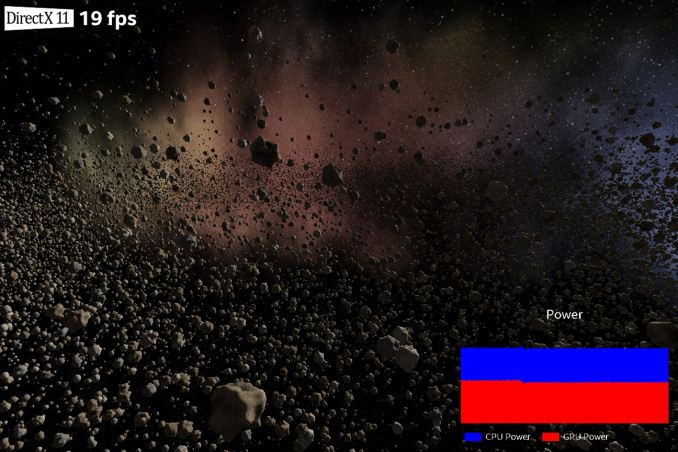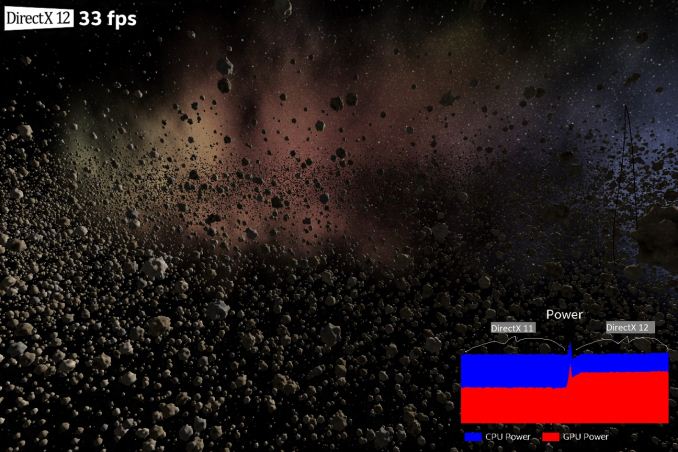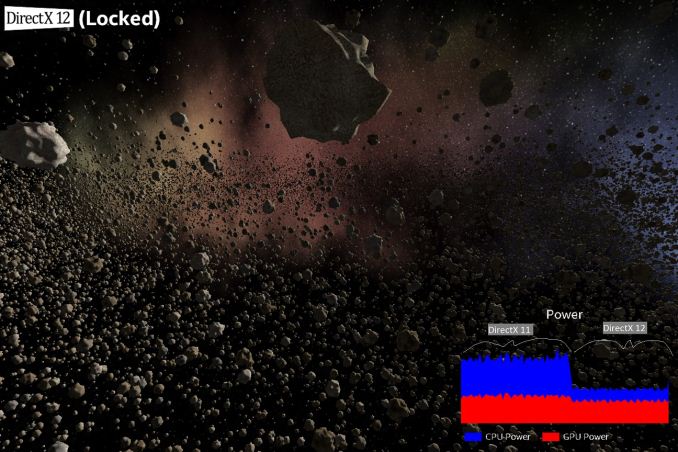Intel Demonstrates Direct3D 12 Performance and Power Improvements
by Stephen Barrett & Ryan Smith on August 15, 2014 6:00 AM EST
Since the introduction of Direct3D 12 and other low-level graphics APIs, the bulk of our focus has been on the high end. One of the most immediate benefits to these new APIs is their ability to better scale out with multiple threads and alleviate CPU bottlenecking, which has been a growing problem over the years due to GPU performance gains outpacing CPU performance gains.
However at the opposite end of the spectrum and away from the performance benefits are the efficiency benefits, and those are gains that haven’t been covered nearly as well. With that subject in mind, Intel is doing just that this week at SIGGRAPH 2014, where the company is showcasing both the performance and efficiency gains from Direct3D 12 on their hardware.
When it comes to power efficiency Intel stands to be among the biggest beneficiaries of Direct3D 12 due to the fact that they exclusvely ship their GPUs as part of an integrated CPU/GPU product. Because the GPU and CPU portions of their chips share a thermal and power budget, by reducing the software/CPU overhead of Direct3D, Intel can offer both improved performance and power usage with the exact same silicon in the same thermal environment. With Intel's recent focus on power consumption, mobile form factors, and chips like Core M, Direct3D 12 is an obvious boon to Intel.
Intel wisely demonstrated this improvement using a modern low-power mobile device: the Microsoft Surface Pro 3. For this demo Intel is using the Core i5-4300U version, Microsoft’s middle of the road model that clocks up to 2.9GHz on the CPU and features one of Intel’s HD 4400 GPUs, with a maximum GPU clockspeed of 1.1GHz. In our testing, we found the Surface Pro 3 to be thermally constrained – throttling when met with a medium to long duration GPU task. Broadwell should go a long way to improve the situation, and so should Direct3D 12 for current and future Intel devices.
To demonstrate the benefits of Direct3D 12, Intel put together a tech demo that renders 50,000 unique asteroid objects floating in space. The demo can operate in maximum performance mode with the frame rate unrestricted, as well as a fixed frame rate mode to limit CPU and GPU utilization in order to reduce power consumption. The demo can also dynamically switch between making Direct3D 11 and Direct3D 12 API calls. Additionally, an overlay shows power consumption of both the CPU and GPU portions of the Intel processor.
Intel states this demo data was taken after steady-state thermals were reached.
In the performance mode, Direct3D 11 reaches 19 frames per second and the power consumption is roughly evenly split between CPU and GPU. Confirming that while this is a graphical demo, there is significant CPU activity and overhead from handling so many draw calls.
After dynamically switching to Direct3D 12 while in performance mode, the frames per second jumps nearly 75% to 33fps and the power consumption split goes from 50/50 (CPU/GPU) to 25/75. The lower CPU overhead of making Direct3D 12 API calls versus Direct3D 11 API calls allows Intel's processor to maintain its thermal profile but shift more of its power budget to the GPU, improving performance.
Finally, in the power efficiency focused fixed frame rate mode, switching between Direct3D 11 and 12 slightly reduces GPU power consumption but dramatically reduces CPU power consumption, all while maintaining the same 19fps frame rate. Intel's data shows a 50% total power reduction, virtually all of which comes from CPU power savings. As Intel notes, not only do they save power from having to do less work overall, but they also save power because they are able to better distribute the workload over more CPU cores, allowing each core in turn to run at a lower clockspeed and voltage for greater power efficiency.
To put these numbers in perspective, a 50% reduction in power consumption is about what we would see from a new silicon process (i.e. moving from 22nm to 14nm), so to achieve such a reduction in consumption with software alone is a very significant result and a feather in Microsoft’s cap for Direct3D 12. If this carries over to when DirectX 12 games and applications launch in Q4 2015, it could help usher in a new era of mobile gaming and high end graphics. It is not often we see such a substantial power and performance improvement from a software update.













42 Comments
View All Comments
iLovefloss - Friday, August 15, 2014 - link
Did you even read the article before making such a comment? The main point of DirectX12 isn't about increasing GPU performance (it still does that of course); DirectX 12 was created to eliminate inefficiencies in the code and reduce CPU usage. Reducing CPU usage (and smarter use of multicore processors) has allowed up to a 50% decrease in power consumption. How, in the loving fuck, is that not something that low-power mobile devices would want?Low-end devices will get more powerful over time as CPUs and GPU get better and better, so it really doesn't matter if DirectX 12 doesn't immediately increase performance relative to the graphics. A performance increase will be there. Compare what you could get for $200 in a phone or phablet form factor to what you could've gotten three years ago. Stuff is getting much more powerful especially the GPUs.
But even if that wasn't the case, if you don't lock the framerate, you can benefit from the increased performance. Drastically increased performance for not a bit more power consumption will be a huge boon for the mobile gaming market.
garadante - Friday, August 15, 2014 - link
Before bashing on him with such colorful language, pay attention to what he's saying. What he said is effectively that devs will increase the number of draw calls in their games with the reduced overhead, bringing up CPU power consumption to the same level as before DX12 but increasing the graphical quality of the game. This would work to reduce power consumption only if game developers don't use the newly unutilized CPU resources to introduce heavier features into game.MikeMurphy - Sunday, August 17, 2014 - link
I guess you've never heard of the Xbox One.azazel1024 - Friday, August 15, 2014 - link
I dunno, I'd consider my Asus T100 as part of the mobile market and I certianly wouldn't mind a good boost either in power on time or in frame rates in games from reduced CPU and/or GPU load for the same frame rate.Understandably, and sadly, I am sure the Bay Trail-T in there won't ever support Dx12, but I probably won't have the T100 when Dx12 hits the market anyway. I'd much prefer lower cost and lower power Atom based processor in my 10.1" tablet through the future anyway, no matter what Broadwell M and future low power Core based processors can deliver. Atom is likely to always be lower, but the performance delta between the two looks likely to shrink further and I won't mind that at all.
Speedfriend - Friday, August 15, 2014 - link
@azazel1024Just bought a Asus T100, what a fantastic little machine, sure the screen isn't great, but its fast, has full office and a keyboard for half the price of an iPad, plus for $25 I added 64Gb of extra storage. Can't wait to see what the next version is like.
haukionkannel - Friday, August 15, 2014 - link
Yep. T100 is a good device! And sequel will be really interesting to see!SunnyNW - Saturday, August 16, 2014 - link
Seems like the perfect time for Microsoft to introduce a low-level api...They had no real motivation before... The PC market has matured and consumers are hanging on to older hardware, what do you do to...You want to include these people and make them a part of your consumer base...Games are only getting more demanding...fteoath64 - Saturday, August 16, 2014 - link
AMD"s Mantle is a "wake up call to MS". Sure DX11 and DX12 are propreitary and subjected to MicroSoft's whims as to when and where they will deploy it. Why not go Open GL 4.4 instead ?. That is an open standard and scalable over multiple architectures and platforms too.The fact the Windows 9 will have DX12 is just an attractor to their product. "Games are going to scream!", they will claim.
Oh, games already scream on consoles and high-end tablets, thank you!. The lowly PC really needs a mid-range video card costing half a tablet to be in on the games. I am sure consumers are changing the way they play and look at gaming in general.
lilmoe - Saturday, August 16, 2014 - link
"so to achieve such a reduction in consumption with software alone is a very significant result and a feather in Microsoft’s cap for Direct3D 12"Just tells you how much more room there is for software to improve.
c plus plus - Saturday, August 16, 2014 - link
thats my microsoft d3d12